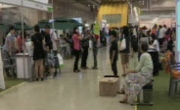After 3.1 independence movement, the passion for education among Chosun people rose at a remarkable pace. This was due to the theory of cultivation of national ability that aimed to have people be prepared for the future independence by nurturing nati...
http://chineseinput.net/에서 pinyin(병음)방식으로 중국어를 변환할 수 있습니다.
변환된 중국어를 복사하여 사용하시면 됩니다.
- 中文 을 입력하시려면 zhongwen을 입력하시고 space를누르시면됩니다.
- 北京 을 입력하시려면 beijing을 입력하시고 space를 누르시면 됩니다.
https://www.riss.kr/link?id=A82574159
- 저자
- 발행기관
- 학술지명
- 권호사항
-
발행연도
2010
-
작성언어
Korean
- 주제어
-
자료형태
학술저널
-
수록면
85-142(58쪽)
- 제공처
- 소장기관
-
0
상세조회 -
0
다운로드
부가정보
다국어 초록 (Multilingual Abstract)
For this reason, Chosun people waged a movement of establishing public schools, or built private educational institutions such as private schools or night schools in their village by themselves. As private educational institutions established in Daejon, there were private schools and night schools for normal education, and training schools for job training, and a kindergarten for childhood education. Of them, the private schools and night schools were responsible for classes taught in public schools. However, they had to go through difficulties associated with operation cost. What's more, the Japanese authority officially announced rules on private schools in 1930s, and carried out the closing of schools on a large scale.
Due to the rules, most of the night schools and private schools that could not meet the requirements set by the Japanese authority had to be closed, and only a part of them could survive. Thus, poor children who lost their learning place scrambled to the remaining schools. Then the private general educational institutions grew on a large scale, but their difficulties in operation were also aggravated. These schools were barely managed with the help of people, parents and others who strongly felt the necessity of education.
After 3.1 independence movement, the passion for education among Chosun people rose at a remarkable pace. This was due to the theory of cultivation of national ability that aimed to have people be prepared for the future independence by nurturing national capabilities. Along with this, the desire for better life through education was also another factor that increased the passion for education. However, the Japanese authority was indifferent to establishing educational institutions that could serve the interests of Chosun people.
For this reason, Chosun people waged a movement of establishing public schools, or built private educational institutions such as private schools or night schools in their village by themselves. As private educational institutions established in Daejon, there were private schools and night schools for normal education, and training schools for job training, and a kindergarten for childhood education. Of them, the private schools and night schools were responsible for classes taught in public schools. However, they had to go through difficulties associated with operation cost. What's more, the Japanese authority officially announced rules on private schools in 1930s, and carried out the closing of schools on a large scale.
Due to the rules, most of the night schools and private schools that could not meet the requirements set by the Japanese authority had to be closed, and only a part of them could survive. Thus, poor children who lost their learning place scrambled to the remaining schools. Then the private general educational institutions grew on a large scale, but their difficulties in operation were also aggravated. These schools were barely managed with the help of people, parents and others who strongly felt the necessity of education.
목차 (Table of Contents)
- 1. 머리말
- 2. 식민지 교육정책과 대전지역
- 3. 사립교육기관의 설립현황과 실태
- 4. 맺음말
- 〈참고문헌〉
- 1. 머리말
- 2. 식민지 교육정책과 대전지역
- 3. 사립교육기관의 설립현황과 실태
- 4. 맺음말
- 〈참고문헌〉
- Abstracts
동일학술지(권/호) 다른 논문
-
- 충남대학교 충청문화연구소
- 방은순(Bang Eun-Sun)
- 2010
-
- 충남대학교 충청문화연구소
- 정만호(Jeong Man-ho)
- 2010
-
- 충남대학교 충청문화연구소
- 백주현(Baek Ju-Hyun)
- 2010
-
- 충남대학교 충청문화연구소
- 김상기(Kim Sangki)
- 2010




 DBpia
DBpia







